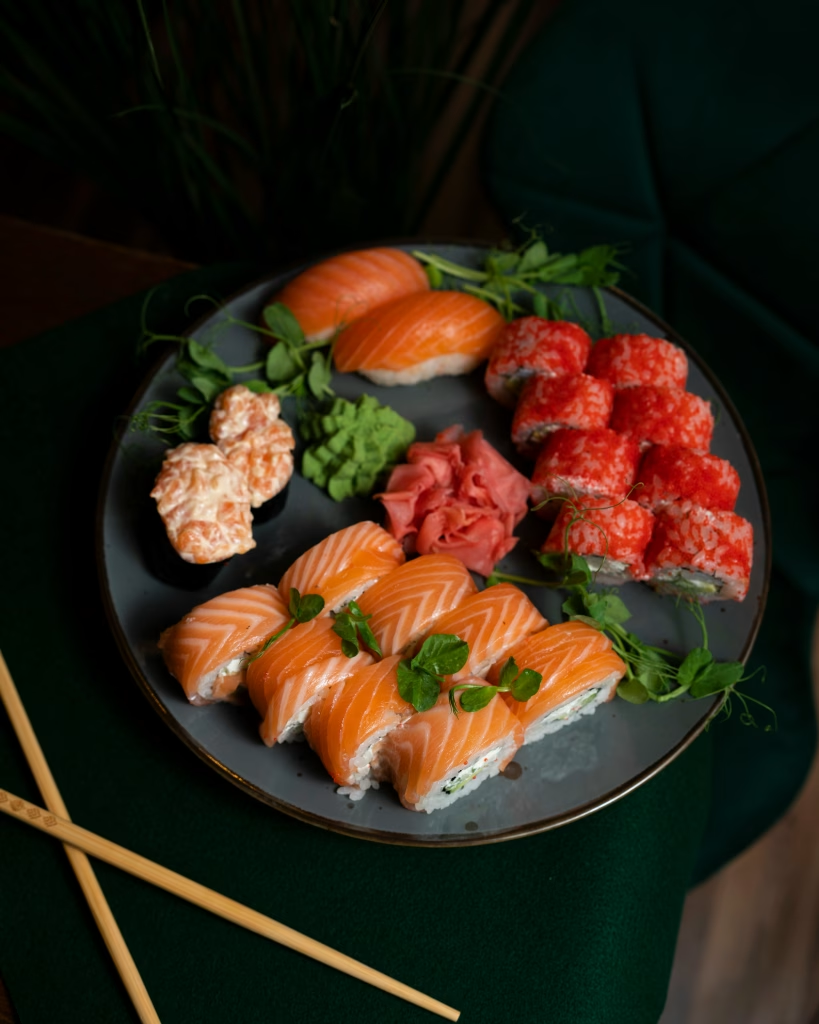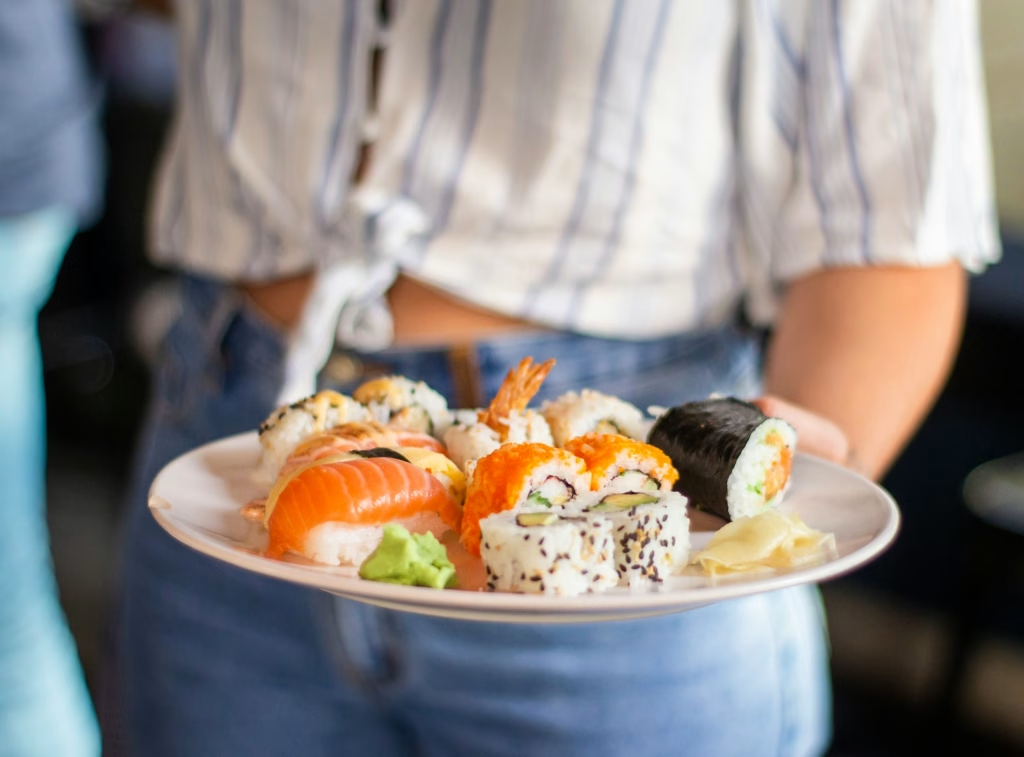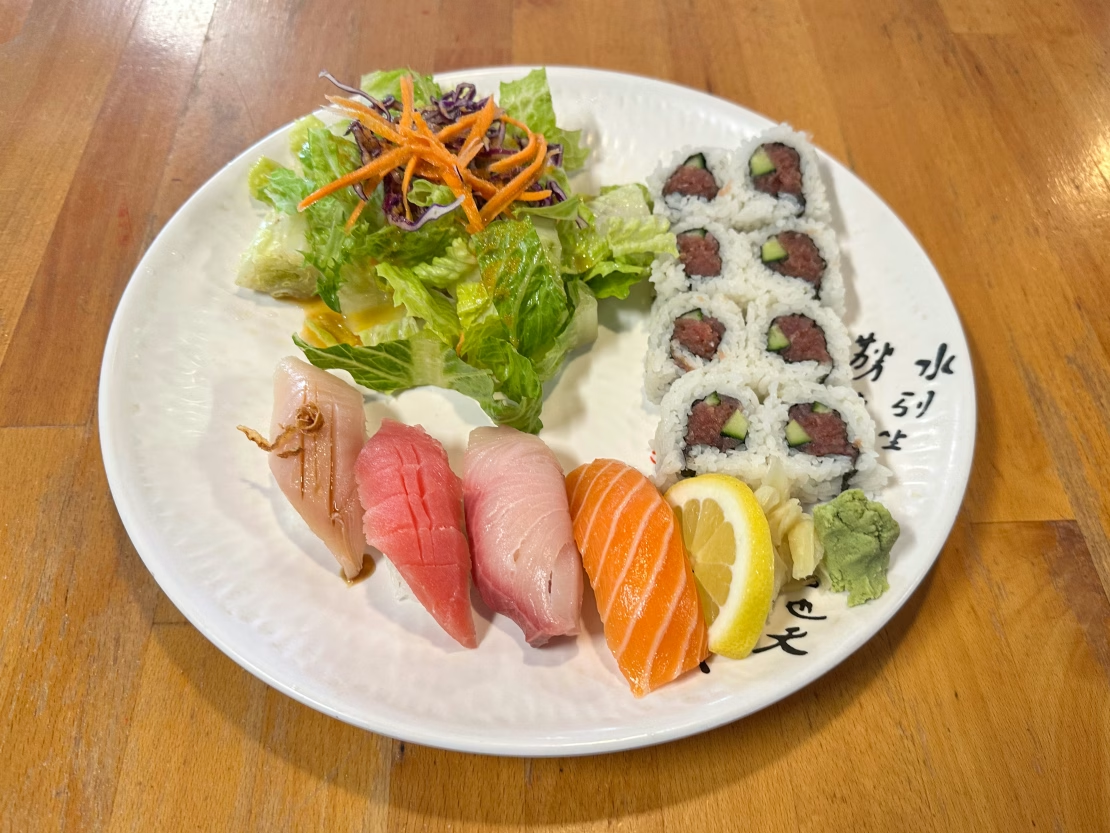Sushi with Tuna or Salmon is one of the most iconic dishes in Japanese cuisine, loved worldwide for its balance of simplicity, elegance, and flavor.
Whether served as nigiri (hand-pressed rice with a slice of fish) or as maki (rolled sushi), this dish celebrates the quality of its ingredients; particularly fresh, sashimi-grade tuna or salmon.
With its origins deeply rooted in centuries-old traditions of preserving fish with rice, sushi has evolved into a modern culinary art form. Sushi with Tuna or Salmon is a fantastic introduction to Japanese sushi-making for home cooks, combining umami-rich seafood with subtly seasoned rice and a touch of wasabi, soy sauce, or pickled ginger.
Table of Contents
Ingredients
For the Sushi Rice:
- 2 cups Japanese short-grain rice (sushi rice)
- 2 ½ cups water (for cooking rice)
- ¼ cup rice vinegar
- 2 tablespoons sugar
- 1 teaspoon salt
For the Fish:
- 200g (7 oz) sashimi-grade tuna (maguro), sliced thinly
- 200g (7 oz) sashimi-grade salmon, sliced thinly
- Optional: seared salmon or spicy tuna mix (for variation)
Other Essentials:
- Nori (seaweed sheets) – for maki rolls
- Wasabi paste (optional)
- Soy sauce (for dipping)
- Pickled ginger (gari)
- Toasted sesame seeds (optional)
- Thinly sliced scallions or chives (optional)
Equipment Needed:
- Bamboo sushi rolling mat (makisu)
- Sharp knife
- Rice paddle or wooden spoon
- Bowl of water (to wet hands)
Serves
Serves 4 as a main course or 6–8 as an appetizer
Step-by-Step Instructions
1. Prepare the Sushi Rice
- Rinse the sushi rice under cold water until the water runs clear. Drain well.
- Cook the rice in a rice cooker or pot with 2½ cups of water.
- While the rice cooks, mix rice vinegar, sugar, and salt in a small pan. Heat gently just until sugar dissolves.
- Once rice is cooked, transfer it to a wooden or plastic bowl. Gently fold in the vinegar mixture while fanning the rice to cool it. Do not mash. Cover with a damp towel.
2. Slice the Fish
- Use a very sharp knife to cut thin, even slices of tuna and salmon against the grain. Each slice should be 2–3 inches long and about ⅛-inch thick.
- Store in the fridge until ready to use. Handle as little as possible to maintain freshness.
3. Shape Nigiri (Hand-Pressed Sushi)
- Wet your hands with water (a little rice vinegar can be added to prevent sticking).
- Take about a tablespoon of rice and shape it into an oval.
- Dab a small amount of wasabi on one side of the fish slice.
- Press the fish slice over the rice, wasabi-side down. Press gently to shape.
4. Make Maki Rolls
- Place a nori sheet (shiny side down) on a bamboo mat.
- Spread an even layer of sushi rice over the nori, leaving 1 inch at the top.
- Lay fish slices (or chopped spicy tuna/salmon) horizontally across the rice.
- Roll tightly using the mat, applying even pressure. Seal the edge with a bit of water.
- Slice with a wet sharp knife into 6–8 pieces.
5. Serve
- Arrange on a platter with wasabi, pickled ginger, and small bowls of soy sauce.
- Garnish maki rolls with sesame seeds or scallions if desired.

Serving Suggestions
- Sushi Platter: Serve a mix of nigiri and maki for variety.
- With Miso Soup: A warm, comforting side that complements cold sushi.
- With Edamame or Seaweed Salad: For a traditional Japanese touch.
- Sushi Bento Box: Pair with tempura, rice, and pickles.
- With Sake or Green Tea: Classic beverage pairings.
Tips for Perfect Sushi with Tuna or Salmon
- Use Sashimi-Grade Fish: Only purchase from trusted seafood markets to ensure freshness and safety.
- Keep Everything Cool and Clean: Sushi-making requires hygiene and cool temperatures for best results.
- Rinse Rice Thoroughly: This removes excess starch and prevents stickiness.
- Do Not Overwork the Rice: Handle gently to preserve texture.
- Use a Wet Knife: Prevents sticking when slicing rolls.
- Don’t Overfill Rolls: It makes them hard to roll and more likely to break.
- Store Fish Properly: Keep refrigerated and use the same day it’s purchased.
Healthier Alternatives
- Brown Rice Sushi: Use short-grain brown rice for added fiber.
- Low-Sodium Soy Sauce: Reduces salt intake while maintaining umami.
- No-Rice Sushi (Sashimi): Eliminate rice entirely for low-carb diets.
- Avocado Instead of Mayonnaise in Spicy Rolls: A creamy, heart-healthy substitute.
- Vegetarian Sushi: Try using cucumber, avocado, or tofu for a plant-based option.
Creative Variations
- Spicy Tuna Rolls: Mix chopped tuna with sriracha and mayo.
- Seared Salmon Sushi: Lightly torch the top of nigiri for smoky flavor.
- Tuna Tartare Nigiri: Top rice with finely diced tuna, scallions, and sesame oil.
- Salmon Mango Rolls: Add fresh mango for a tropical twist.
- Sushi Burritos: Large seaweed rolls filled with sushi ingredients, eaten like a wrap.
Common Mistakes to Avoid
- Using Non-Sushi Rice: Regular long-grain rice won’t have the right stickiness.
- Skipping Vinegar Seasoning: The rice needs flavor and acidity.
- Handling Fish Too Much: Can lead to warming and loss of texture.
- Using Too Much Wasabi or Soy Sauce: Overwhelms the delicate flavor of the fish.
- Slicing Rolls with a Dry Knife: Causes tearing and uneven cuts.
- Packing Rice Too Tightly: Leads to gummy, dense nigiri.
- Leaving Fish at Room Temperature Too Long: Increases food safety risks.
History
Ancient Origins of Sushi
Sushi began as a method of preserving fish in fermented rice in Southeast Asia. This technique made its way to Japan as early as the 8th century, where it evolved into a cuisine. Initially, rice was discarded after fermenting the fish, but over centuries, the Japanese began eating both rice and fish together.

Edo-Period Transformation
During the Edo period (1603–1868), the fast-food version of sushi—called nigiri-zushi—was born in Tokyo (then Edo). This was when sushi began to resemble what we know today, with raw slices of fish placed atop hand-molded vinegared rice. Tuna, being abundant and flavorful, quickly became a popular topping among the working class.

Rise of Salmon in Sushi Culture
Salmon wasn’t traditionally eaten raw in Japan due to concerns about parasites. However, after improved freezing techniques were introduced in the 20th century, particularly through Norway’s successful salmon export campaign in the 1980s, salmon sushi gained popularity. Today, both tuna and salmon are global sushi staples, thanks to their rich taste, texture, and health benefits.
FAQs about Sushi with Tuna or Salmon
1. What does “sashimi-grade” mean?
It means the fish is safe to eat raw, typically handled and frozen under specific guidelines to kill parasites.
2. Can I freeze fish for sushi?
Yes, but it must be frozen at -20°C (-4°F) for at least 7 days to ensure safety for raw consumption.
3. What’s the difference between nigiri and sashimi?
Nigiri includes rice; sashimi is just thin slices of raw fish, no rice.
4. Is sushi rice necessary, or can I use regular rice?
Only short-grain Japanese rice provides the stickiness and texture required for sushi.
5. How long can sushi be stored?
Ideally, eat within a few hours. Maximum 24 hours in the refrigerator if well wrapped.
6. Is it safe to eat raw tuna or salmon?
Yes, if it’s labeled sashimi-grade and handled properly.
7. Can I make sushi ahead of time?
Prepare just a few hours before serving. Rice dries out and fish degrades quickly.
8. What are the best sauces for tuna or salmon sushi?
Soy sauce, ponzu, spicy mayo, or yuzu-based sauces pair well.
9. What’s the green paste served with sushi?
Wasabi – a spicy Japanese horseradish that complements raw fish.
10. What can I serve with sushi to make a full meal?
Miso soup, seaweed salad, tempura, and green tea are excellent sides.
Sushi with Tuna or Salmon is a beautiful blend of tradition, artistry, and clean eating. Whether you’re preparing delicate nigiri or hearty maki rolls, this dish brings the elegance of Japanese cuisine right into your kitchen. With high-quality ingredients, the right tools, and a bit of practice, anyone can master this globally loved recipe. Fresh, flavorful, and versatile, sushi made with tuna or salmon is not only a delight for the palate but also a nourishing choice for a light meal or an elaborate dinner spread.


